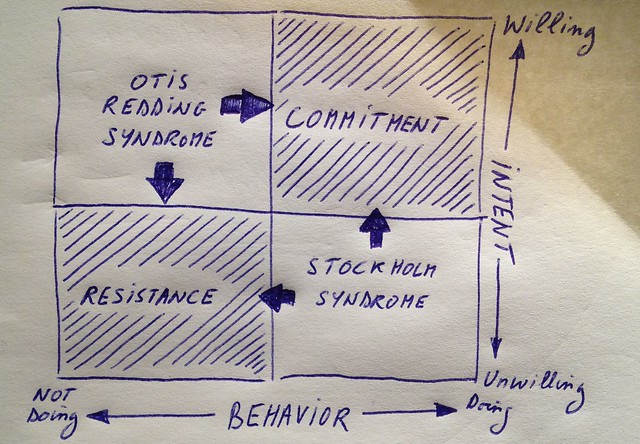Transforming the community by inverting the way we manage resistance? That’s another one of those counterintuitive things you need to know about community development.
One thing I haven’t mentioned yet in this series of Community Development is the importance of managing resistance and how it is an integral part of the community development process. In short: the approach we choose to take on managing resistance will make or break the community.
Remember the resistance pregnancy test that I often refer to. It describes the different forms of resistance charted on two dimensions: intent (willing or unwilling) and behavior (acting or not acting). There are four different types of resistance that occur in that model; two of them are toxic and drain the energy away from the project, and the other two are power generators. For more background on the resistance pregnancy test, check out this article.
Earlier in this series I stated that our work as practitioners is to build the capacity of community members to be accountable and to become creators of community. When it comes to managing resistance, this means that we should be aware of the behaviors that are authentic (commitment AND resistance) as opposed to those who are not (the two syndromes).
Most of all, it means that in our day-to-day business we should reward authentic behavior and put firm boundaries on inauthentic behavior. But the problem is that this goes against our management education. The way we function today is opposed to what is really needed for community development. To sum up how we manage the four types of resistance on the resistance pregnancy test versus what is needed for a community to develop:
- As Is: When people demonstrate commitment and engagement we take it for granted.
To Be: Pay attention to commitment with the same discipline and frequency as we are policing bad or undesired behaviors. - As Is: When people express disagreement towards a project or an initiative we defend ourselves or try to minimize the opposition by making excuses – either for ourselves or for the person.
To Be: When people express disagreement; instead of defending ourselves or finding excuses, we could be interested and respect it for what it is: an authentic expression of doubt or unwillingness. The point we really need to get is that disagreement does not equal disloyalty. And it is precisely our acceptance of the expression of disagreement that signals that disagreement does not cost your membership (to the contrary!) - As Is: We hardly ever act on inauthentic behaviors because they are always socially accepted. As a result, this implicitly communicates that we tolerate people who are not being accountable for their actions.
To Be: Most people freak out when I give this advice, but it is the one thing that transforms a community. You need to set boundaries by making the lack of accountability explicit and (eventually – if no improvement is happening) by kicking people out of the community. This is a very awkward thing to do because very often the people you are up against are mostly ‘friendly’ people. Believe me, this is the only way to signal to committed people that you are holding the space for accountability.
So there you go: being interested in what the naysayers have to say and setting firm boundaries to what the lip service people have to offer. With this approach I can guarantee two things:
- you will be in for a roller coaster ride
- you are transforming your community



